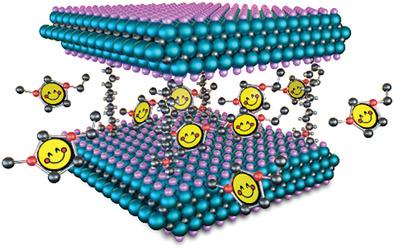当前位置:
X-MOL 学术
›
Adv. Funct. Mater.
›
论文详情
Our official English website, www.x-mol.net, welcomes your
feedback! (Note: you will need to create a separate account there.)
Engineering the Interlayer Spacing by Pre-Intercalation for High Performance Supercapacitor MXene Electrodes in Room Temperature Ionic Liquid
Advanced Functional Materials ( IF 18.5 ) Pub Date : 2021-06-18 , DOI: 10.1002/adfm.202104007 Kun Liang 1 , Ray A. Matsumoto 2 , Wei Zhao 2 , Naresh C. Osti 3 , Ivan Popov 4 , Bishnu P. Thapaliya 4, 5 , Simon Fleischmann 6 , Sudhajit Misra 7 , Kaitlyn Prenger 1 , Madhusudan Tyagi 8, 9 , Eugene Mamontov 3 , Veronica Augustyn 6 , Raymond R. Unocic 7 , Alexei P. Sokolov 4, 5 , Sheng Dai 4, 5 , Peter T. Cummings 2 , Michael Naguib 1
Advanced Functional Materials ( IF 18.5 ) Pub Date : 2021-06-18 , DOI: 10.1002/adfm.202104007 Kun Liang 1 , Ray A. Matsumoto 2 , Wei Zhao 2 , Naresh C. Osti 3 , Ivan Popov 4 , Bishnu P. Thapaliya 4, 5 , Simon Fleischmann 6 , Sudhajit Misra 7 , Kaitlyn Prenger 1 , Madhusudan Tyagi 8, 9 , Eugene Mamontov 3 , Veronica Augustyn 6 , Raymond R. Unocic 7 , Alexei P. Sokolov 4, 5 , Sheng Dai 4, 5 , Peter T. Cummings 2 , Michael Naguib 1
Affiliation

|
MXenes exhibit excellent capacitance at high scan rates in sulfuric acid aqueous electrolytes, but the narrow potential window of aqueous electrolytes limits the energy density. Organic electrolytes and room-temperature ionic liquids (RTILs) can provide higher potential windows, leading to higher energy density. The large cation size of RTIL hinders its intercalation in-between the layers of MXene limiting the specific capacitance in comparison to aqueous electrolytes. In this work, different chain lengths alkylammonium (AA) cations are intercalated into Ti3C2Tx, producing variation of MXene interlayer spacings (d-spacing). AA-cation-intercalated Ti3C2Tx (AA-Ti3C2), exhibits higher specific capacitances, and cycling stabilities than pristine Ti3C2Tx in 1 m 1-ethly-3-methylimidazolium bis-(trifluoromethylsulfonyl)-imide (EMIMTFSI) in acetonitrile and neat EMIMTFSI RTIL electrolytes. Pre-intercalated MXene with an interlayer spacing of ≈2.2 nm, can deliver a large specific capacitance of 257 F g−1 (1428 mF cm−2 and 492 F cm−3) in neat EMIMTFSI electrolyte leading to high energy density. Quasi elastic neutron scattering and electrochemical impedance spectroscopy are used to study the dynamics of confined RTIL in pre-intercalated MXene. Molecular dynamics simulations suggest significant differences in the structures of RTIL ions and AA cations inside the Ti3C2Tx interlayer, providing insights into the differences in the observed electrochemical behavior.
中文翻译:

在室温离子液体中通过预插层设计高性能超级电容器 MXene 电极的层间距
MXenes 在硫酸水溶液电解质中以高扫描速率表现出优异的电容,但水溶液电解质的窄电位窗口限制了能量密度。有机电解质和室温离子液体 (RTIL) 可以提供更高的电位窗口,从而导致更高的能量密度。与水性电解质相比,RTIL 的大阳离子尺寸阻碍了它在 MXene 层之间的嵌入,从而限制了比电容。在这项工作中,不同链长的烷基铵 (AA) 阳离子被插入到 Ti 3 C 2 T x 中,产生了 MXene 层间距 ( d -spacing) 的变化。AA-阳离子插层 Ti 3 C 2 T x(AA-Ti 3 C 2 ),在乙腈和纯 EMIMTFSI中的 1 m 1-乙基-3-甲基咪唑鎓双-(三氟甲基磺酰基)-酰亚胺 (EMIMTFSI) 中表现出比原始 Ti 3 C 2 T x更高的比电容和循环稳定性RTIL 电解质。具有≈2.2 nm 层间距的预嵌入 MXene,可以提供 257 F g -1(1428 mF cm -2和 492 F cm -3) 在纯 EMIMTFSI 电解质中导致高能量密度。准弹性中子散射和电化学阻抗谱用于研究预嵌入 MXene 中受限 RTIL 的动力学。分子动力学模拟表明 Ti 3 C 2 T x夹层内的 RTIL 离子和 AA 阳离子的结构存在显着差异,从而深入了解所观察到的电化学行为的差异。
更新日期:2021-08-17
中文翻译:

在室温离子液体中通过预插层设计高性能超级电容器 MXene 电极的层间距
MXenes 在硫酸水溶液电解质中以高扫描速率表现出优异的电容,但水溶液电解质的窄电位窗口限制了能量密度。有机电解质和室温离子液体 (RTIL) 可以提供更高的电位窗口,从而导致更高的能量密度。与水性电解质相比,RTIL 的大阳离子尺寸阻碍了它在 MXene 层之间的嵌入,从而限制了比电容。在这项工作中,不同链长的烷基铵 (AA) 阳离子被插入到 Ti 3 C 2 T x 中,产生了 MXene 层间距 ( d -spacing) 的变化。AA-阳离子插层 Ti 3 C 2 T x(AA-Ti 3 C 2 ),在乙腈和纯 EMIMTFSI中的 1 m 1-乙基-3-甲基咪唑鎓双-(三氟甲基磺酰基)-酰亚胺 (EMIMTFSI) 中表现出比原始 Ti 3 C 2 T x更高的比电容和循环稳定性RTIL 电解质。具有≈2.2 nm 层间距的预嵌入 MXene,可以提供 257 F g -1(1428 mF cm -2和 492 F cm -3) 在纯 EMIMTFSI 电解质中导致高能量密度。准弹性中子散射和电化学阻抗谱用于研究预嵌入 MXene 中受限 RTIL 的动力学。分子动力学模拟表明 Ti 3 C 2 T x夹层内的 RTIL 离子和 AA 阳离子的结构存在显着差异,从而深入了解所观察到的电化学行为的差异。





















































 京公网安备 11010802027423号
京公网安备 11010802027423号